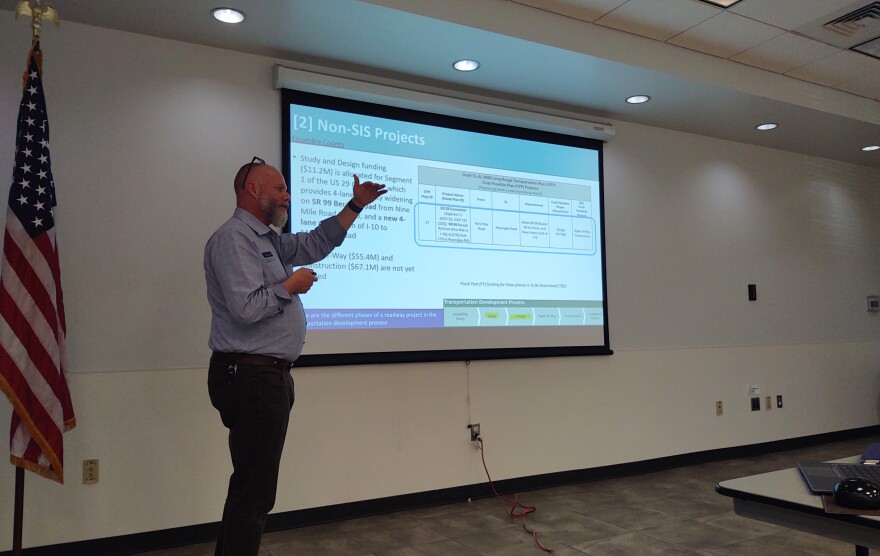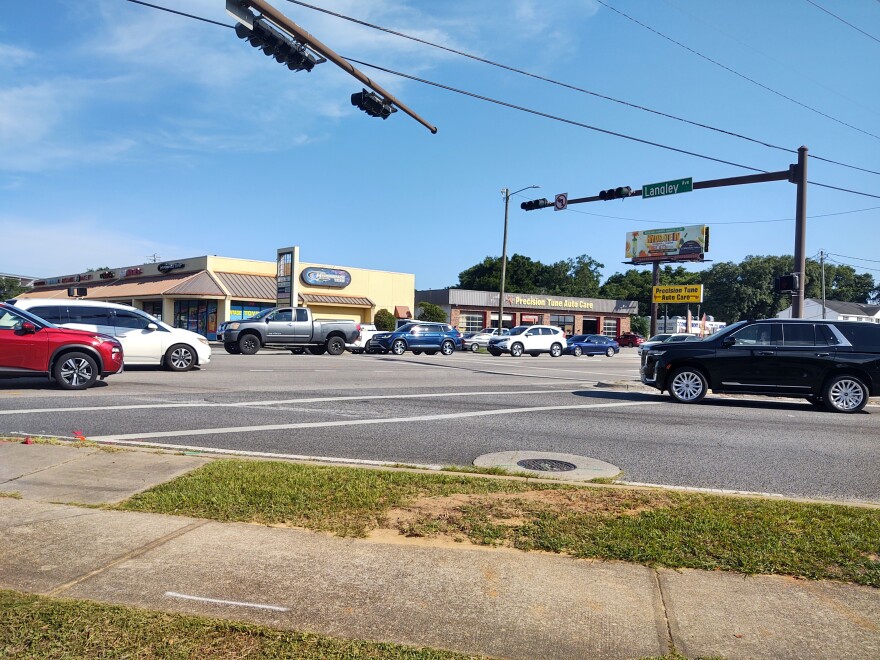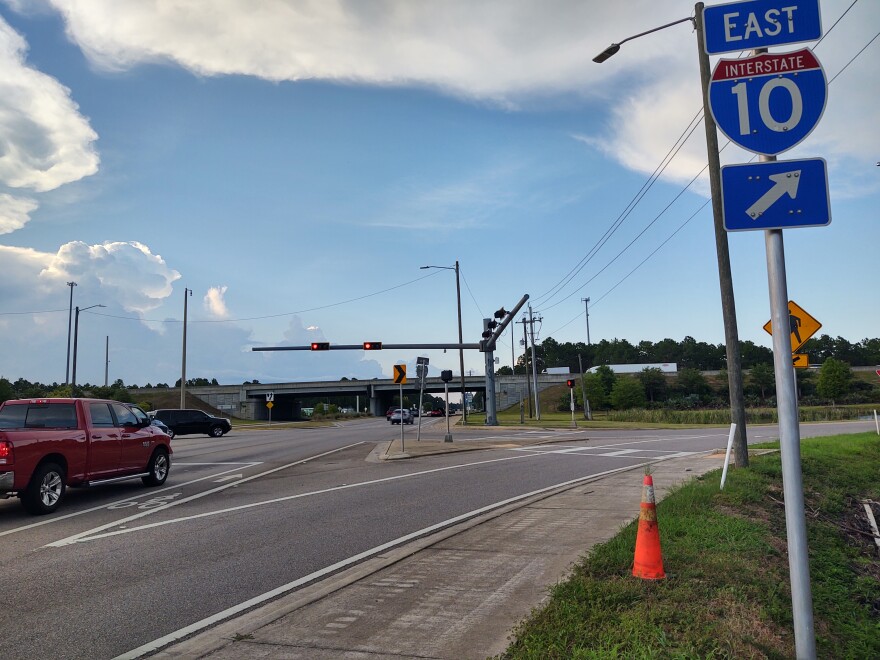The Florida-Alabama Transportation Planning Organization (TPO) is seeking public input on how limited transportation funding should be prioritized over the next couple of decades. The feedback will aid development of the region’s 25-year long-range plan.
Support Local Stories. Support Public Media.
Among the numerous projects included in the 2050 Long Range Transportation Plan is the widening of U.S. Highway 90 to six lanes from Scenic Highway in Escambia County east to Stewart Street in Milton. The intersection at Bell Lane connects two of the five segments.
Design funding of $18.6 million is allocated for all segments of the 23-mile widening plan, but the timetable has not been determined, and no funding has been identified for the nearly $700 million cost of right-of-way acquisition and construction.
This type of information was presented in a recent series of workshops to go over the Cost Feasible Plan portion of the FL-AL TPO’s 2050 Plan for Escambia and Santa Rosa counties, as well as Baldwin County across the state line.
“We update the long-range plan every five years. This is the final step in the process,” said Gary Kramer, who works for the Emerald Coast Regional Council, which staffs the TPO.
He says the long-range plan involves a multi-year process that includes a "needs plan," or a list of needed projects in the region, which was adopted last month. The Cost Feasible Plan is a projection of revenue that will be available to pay for various phases of those projects.

“That was what we presented today. It’s the money we have and based on the Needs Plan, these are the projects from the needs plan we feel like could be funded through 2050,” he explained.
The Cost Feasible Plan, which also highlights what has not yet been budgeted, is divided into three different categories, including Strategic Intermodal System (SIS) projects. SIS is the state’s highest priority for transportation capacity investments, and those projects are set by the Florida Department of Transportation, according to Cory Wilkinson, a senior planner with engineering firm HDR.
“The interstate system statewide is a priority because of tourism, freight, and rail; the movement of commodities, movement of people,” said Wilkinson.
He says this is why there are a number of SIS projects involving the widening of the interstate and other major roadways in the area.
“For the most part, Interstate-10 remains prioritized more highly because it’s 'the' main corridor,” he said. “U.S. 98 falls in there, but most of the priorities are on the interstate system. Then you also have the military access facility, which is Blue Angel Parkway, 173.”
Construction of the SUNTrail ($7 million in FY 27) along Bayfront Parkway is also included on the SIS because of the roadway’s access to the Port of Pensacola.
A total of almost $1.6 billion has been projected to fund SIS projects in Escambia and Santa Rosa counties, from study and design to right-of-way and construction through 2050.
The top SIS priority project for the FL-AL TPO is a new I-10 interchange at Beulah Road, which is now fully funded, with $7.4 million in right-of-way acquisition in the current fiscal year and construction in FY 27 at a cost of $280 million.

Looking out, $267.5 million in funding for the widening of I-10 to six lanes from the weigh station to the Nine Mile Road interchange is projected for FY 30.
Resident Sean Bullington has been closely watching the long-range planning process.
“I-10 was probably the best thing I liked on the list, because it’s very much needed,” he said, applauding plans to improve the interchange and widen Pine Forest Road south of I-10. However, he’s concerned that a small portion of the roadway north of I-10 will not be six-laned.
“Pine Forest Road is really a major road now, and with uncontrolled planning by commissioners, who have broadly not planned things out well, they allowed development to rapidly go into place. But they’re not thinking about the infrastructure, which also affects public safety and tourism, because tourists are going to get off at these intersections to get gas, food, and lodging.”
Other SIS projects include the four-laning of Blue Angel Parkway, the six-laning of I-10 from Avalon Boulevard to the Santa Rosa/Okaloosa County Line, and the widening of Highway 98 from Baybridge Drive east to the Okaloosa County line.
Phil Babiak, a long-time member of the community in Navarre, noted that he’s driven on 98 nearly every day for 50 years and doesn’t think the long-range plan does enough to address congestion on the region’s only east-west transportation corridor along the coast.
“The six-laning is the only thing that shows up here, and the six-laning is already obsolete by a large number and growing at a large number,” said Babiak. “And yet we still don’t even have a line on the paper that shows a possible solution.”
Funding for design phases on 98 is listed for FY 35-40, which, for Babiak, is way too long to wait. He’s long advocated for some sort of bypass on Eglin property, just a few miles north of the coast, in the long-term planning.
“We need to sit down with the people that control the Eglin Reservation and sit down with them and say ‘is it possible for your benefit as well as our benefit that we have a corridor that skirts the southern segment of your Reservation,’” he explained. “We need 200 feet for a four-lane road, there’s no need of designing anything less.

Meanwhile, the Cost Feasible Plan also includes a smaller pot of money totaling $411.1 million for Alabama Projects and other Non-SIS projects in Escambia and Santa Rosa counties.
The top non-SIS priority is the construction of that new traffic management center, which is going to start this year.
“That will really help with congestion,” said Wilkinson. “Without trying to widen roadways, we can better manage the traffic that we have through smart systems.”
For Baldwin County in Alabama, the lone project on the list involves the widening of Canal Road (SR 180) to five lanes. Currently, funding is planned for right-of-way and partial construction.
Public comments on the Cost Feasible Plan, which can influence funding priorities, will be accepted through July 15 and considered when the steering committee meets on that date at the Pensacola Bay Center.
The full FL-AL TPO is expected to take action to adopt the plan at their next meeting in August. The 2050 Long Range Transportation Plan will be finalized near the end of the year.


